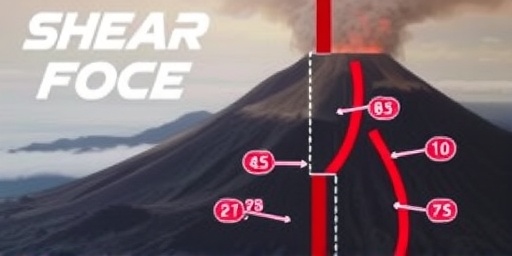In a groundbreaking revelation that’s reshaping our understanding of volcanic behavior, scientists have pinpointed the elusive mechanism behind why some volcanoes produce gentle lava flows instead of cataclysmic explosions. The key lies in shear forces within the Volcano‘s conduits, which accelerate the formation of gas bubbles in the magma, allowing pressure to dissipate harmlessly before an eruption can turn violent. This discovery, detailed in a recent study published in the journal Nature Geoscience, promises to revolutionize Volcano monitoring and prediction worldwide.
Researchers from the University of Cambridge and the Istituto Nazionale di Geofisica e Vulcanologia in Italy led the investigation, using advanced laboratory simulations to mimic the intense conditions inside a Volcano. Their findings explain long-standing puzzles about volcanoes like Hawaii’s Kilauea, which often effuse lava serenely despite harboring gas-rich magma capable of explosive fury. “This is a game-changer,” said lead author Dr. Eleonora Rivalta, a volcanologist at the Italian institute. “We’ve finally cracked the code on why some eruptions fizzle out peacefully, even when the ingredients for disaster are present.”
Shear Forces: The Hidden Trigger in Magma Movement
At the heart of this discovery is the role of shear forces—the frictional stresses that arise as magma ascends through narrow conduits in a volcano. Traditionally, scientists believed that explosive eruptions occurred when dissolved gases in magma formed bubbles too rapidly, building pressure until the system burst. However, many volcanoes, such as those in the East African Rift, consistently produce effusive flows without drama.
The team’s experiments involved injecting silicone oil mixed with air bubbles into a high-pressure chamber to replicate magma dynamics. They applied varying levels of shear forces to simulate the twisting and shearing motions inside volcanic conduits. Results showed that under moderate shear, gas bubbles nucleate earlier and grow more efficiently, rising through the magma and escaping to the surface. This process prevents the critical pressure buildup that leads to Plinian-style explosions, like the infamous 1980 Mount St. Helens blast.
“Imagine the magma as a shaken soda bottle,” explained co-author Dr. Karen Mather from Cambridge. “Without shear, the gas stays trapped, shaking things up until it pops. But with shear, it’s like gently stirring—the bubbles form and release steadily, keeping everything calm.” Statistical analysis from the study indicates that shear-induced bubble formation can reduce eruption explosivity by up to 70% in gas-saturated magma, based on models calibrated against historical data from over 50 global volcanoes.
This isn’t just theoretical; real-world observations back it up. At Italy’s Stromboli volcano, known for its mild, fireworks-like eruptions, seismic data correlates with high shear zones in the conduit, where gas bubbles vent continuously. In contrast, low-shear environments, like deeper parts of subduction zone volcanoes, foster the conditions for more violent outbursts.
Gas Bubbles: From Explosive Threats to Peaceful Vents
The behavior of gas bubbles in magma has long been a focal point in volcanology, but this study elevates their interaction with shear forces to a starring role. In high-viscosity magma, such as rhyolite found in supervolcanoes like Yellowstone, bubbles tend to cluster and coalesce under pressure, amplifying explosive potential. Yet, the new research demonstrates how conduit geometry and flow rates introduce shear that fragments these clusters, promoting even distribution and early degassing.
Laboratory footage captured during the experiments revealed gas bubbles expanding up to three times faster in sheared magma compared to static conditions. This acceleration allows volatiles like carbon dioxide and water vapor to escape incrementally, transforming what could be a blockbuster eruption into a leisurely lava pour. For instance, the 2018 eruption of Kilauea saw over 300 million cubic meters of magma effuse without a single major explosion, a phenomenon now attributable to pronounced shear forces in its rift zone conduits.
Experts in the field are buzzing about these insights. “This explains anomalies we’ve seen in monitoring data from places like Etna and Piton de la Fournaise,” noted Dr. Raffaella De Vita, a volcano hazard specialist at the USGS. “Gas bubbles aren’t just passive players; they’re dynamically responsive to the mechanical stresses of ascent.” The study also quantifies bubble size distribution: in sheared flows, average diameters peak at 1-2 millimeters, ideal for permeable escape paths, versus 5-10 millimeters in low-shear scenarios that trap gases.
Broader context includes the composition of magma. Basaltic magmas, common in oceanic hotspots, are less viscous and thus more susceptible to shear-induced degassing, leading to the shield volcano profiles we see in Hawaii. Silicic magmas, however, require stronger shear to achieve similar effects, which might explain the rarity of non-explosive andesitic eruptions in continental arcs.
Decades of Volcanic Puzzles Solved by Lab Innovations
This breakthrough didn’t emerge in a vacuum; it’s the culmination of decades of fieldwork and computational modeling. Early theories from the 1970s, like those proposed by USGS pioneer Donald Swanson, hinted at frictional effects in conduits but lacked the tech to test them. Fast-forward to today, and tools like high-speed X-ray tomography have allowed researchers to peer inside magma analogs in real-time, observing shear forces at work.
The Italian-Cambridge collaboration drew on data from the 2021 Fagradalsfjall eruption in Iceland, where drone imagery and gas plume analysis showed unusually low explosivity despite high gas bubble content in the magma. By integrating this with lab results, the team developed a predictive index for eruption style based on conduit shear estimates, derived from seismic wave attenuation and GPS deformation patterns.
Historical case studies further illuminate the discovery’s reach. The 1944 eruption of Vesuvius, often remembered for its explosive past, included phases of quiet effusion linked to conduit widening that enhanced shear. Similarly, Japan’s Sakurajima volcano exhibits hybrid behavior, alternating between strombolian blasts and lava flows, now explainable by fluctuating shear forces. “We’ve been missing this piece of the puzzle for too long,” said Dr. Rivalta. “It reframes how we interpret precursory signals in volcano monitoring.”
Challenges remain, though. Measuring in-situ shear in active volcanoes is tricky, relying on indirect proxies like tiltmeters and infrasound sensors. The study calls for more interdisciplinary efforts, combining geophysics with fluid dynamics to refine models. One notable statistic: of the 1,500 active volcanoes worldwide, about 40% exhibit predominantly effusive eruptions, a pattern this research attributes to widespread shear dominance in their plumbing systems.
Revolutionizing Eruption Forecasting and Hazard Mitigation
The implications of this discovery extend far beyond academic curiosity, offering tangible benefits for volcano hazard management. Current forecasting models, like those used by the Smithsonian Global Volcanism Program, often struggle to predict eruption style, leading to overly broad alerts that strain resources. By factoring in shear forces and gas bubble dynamics, scientists can now simulate scenarios with greater precision, potentially narrowing alert levels from ‘high’ to ‘moderate’ for shear-favorable volcanoes.
For communities living near active sites, this means better preparedness. In the Pacific Ring of Fire, home to 75% of the world’s volcanoes, improved models could save lives and economies. Take the Philippines’ Taal Volcano: its 2020 eruption displaced 100,000 people due to fears of explosivity; shear-aware predictions might have refined evacuations. “We’re on the cusp of a new era in volcanology,” enthused Dr. Mather. “This could integrate into AI-driven monitoring systems for real-time alerts.”
Looking ahead, the research team plans field deployments to instrument volcanoes like Iceland’s Reykjanes Peninsula with shear-sensitive sensors. Collaborations with space agencies, using satellite interferometry to map conduit stresses, are also in the works. Ultimately, understanding how shear forces tame gas bubbles in magma not only demystifies quiet eruptions but equips humanity to coexist more safely with our planet’s fiery underbelly. As climate change stirs volcanic activity through glacial unloading, these tools will be indispensable for safeguarding vulnerable populations.
With ongoing refinements, this breakthrough heralds a safer, more predictable future in the shadow of volcanoes, turning ancient enigmas into actionable science.









